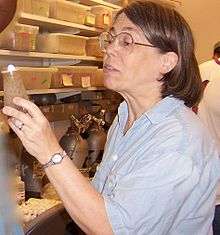Sarah Elgin
| Sarah C.R. Elgin | |
|---|---|
|
Sarah C.R. Elgin | |
| Residence | St. Louis, MO |
| Nationality | American |
| Fields | Biochemistry, Biophysics, Genetics, Epigenetics |
| Institutions | California Institute of Technology; Harvard University; Washington University in St. Louis |
| Alma mater | Pomona College, California Institute of Technology |
| Doctoral advisor | James Bonner |
| Doctoral students | Lee M. Silver, Carl Wu |
| Known for | heterochromatin, science education |
| Notable awards |
|
Sarah C.R. Elgin is an American biologist noted for her work in epigenetics, gene regulation, and heterochromatin and her contributions to science education.
In high school, Elgin studied fallout levels in Oregon rainwater after nuclear weapons tests in the Soviet Union.[1] She received her B.A. in chemistry from Pomona College. While at Pomona, she participated in a summer research program at the University of Leeds characterizing the egg stalk of the green lacewing fly Chrysopa vittata.[2] Elgin did her graduate work in the lab of James Bonner at the California Institute of Technology, isolating and characterizing nonhistone chromosomal proteins from rat livers. She received her Ph.D. in biochemistry in 1972. Elgin stayed at Caltech for her postdoctoral research, working in the lab of Leroy Hood. She continued to isolate and characterize nonhistone chromosomal proteins but started studying Drosophila.
After her postdoc, Elgin joined the faculty at Harvard University, where her lab pioneered immunostaining of polytene chromosomes from Drosophila larval salivary glands[3] and nuclease digestion assays.[4][5]
In 1981, Elgin joined the faculty in the Department of Biology at Washington University in St. Louis. Her lab isolated and characterized Heterochromatin Protein 1 in Drosophila[6] (now known as Su(var)205 or HP1a). To probe chromatin environments, her lab developed a P element construct with a copy of the white gene driven by the hsp70 promoter. When this reporter gene is inserted into heterochromatic environments, the fly eyes display a vareigating phenotype, whereas when the P element is inserted into euchromatin the fly eyes show a red phenotype; this phenomenon is known as Position-effect variegation. Nuclease digestion assays have confirmed that the eye phenotypes are indicative of the chromatin environment surrounding the P element insertion site.[7][8] In 2006, Elgin was named as the inaugural Viktor Hamburger Distinguished Professor in Arts and Sciences .
At Washington University and in the St. Louis area, Elgin has been active in science education. She founded the Washington University Science Outreach program in 1989 and has been active in science education in the University City school district.

In 2002 Elgin became an HHMI Professor with the goal to develop core curriculum to integrate primary research in genomics with a college course called Phage Bioinformatics. This project has been expanded and disseminated as the Genomics Education Partnership , a consortium of 66 member colleges and universities who participate in sequence improvement and annotation projects with the goal of publishing the results in primary research journals.[9][10]
Memberships
- Academy of Science, St. Louis
- American Association for the Advancement of Science
- American Society for Biochemistry and Molecular Biology
- American Society for Cell Biology
- Genetics Society of America
- American Academy of Arts and Sciences
Notes and references
- ↑ http://www.hhmi.org/bulletin/spring-2014/which-mentor-had-biggest-impact-your-career-and-why
- ↑ Roberts, S.C. (1966). "Brief description of the early stages of Chrysopa vittata (Neuroptera Chrysopidae)". Entomologist's Gazette. 17: 85–89.
- ↑ Silver, L M; Elgin, S C (February 1976). "A method for determination of the in situ distribution of chromosomal proteins". Proc Natl Acad Sci U S A. 73 (2): 423–427. doi:10.1073/pnas.73.2.423. PMC 335921
 . PMID 813226.
. PMID 813226. - ↑ Wu, C; Bingham, PM; Livak, KJ; Holmgren, R; Elgin, SCR (April 1979). "The chromatin structure of specific genes: I. Evidence for higher order domains of defined DNA sequence". Cell. 16 (4): 797–806. doi:10.1016/0092-8674(79)90095-3. PMID 455449.
- ↑ Wu, C; Wong, YC; Elgin, SCR (April 1979). "The chromatin structure of specific genes: II. Disruption of chromatin structure during gene activity". Cell. 16 (4): 807–814. doi:10.1016/0092-8674(79)90096-5. PMID 455450.
- ↑ James, TC; Elgin, SCR (November 1986). "Identification of a nonhistone chromosomal protein associated with heterochromatin in Drosophila melanogaster and its gene". Mol Cell Biol. 6 (11): 3862–3872. PMC 367149
 . PMID 3099166.
. PMID 3099166. - ↑ Wallrath, LL; Elgin, SCR (1995-05-15). "Position effect variegation in Drosophila is associated with an altered chromatin structure". Genes & Development. 9 (10): 1263–1277. doi:10.1101/gad.9.10.1263. PMID 7758950.
- ↑ Sun, FL; Cuaycong, MH; Elgin, SCR (April 2001). "Long-Range Nucleosome Ordering Is Associated with Gene Silencing in Drosophila melanogaster Pericentric Heterochromatin". Mol Cell Biol. 21 (8): 2867–2879. doi:10.1128/MCB.21.8.2867-2879.2001. PMC 86916
 . PMID 11283265.
. PMID 11283265. - ↑ Slawson, EE; Shaffer, CD; Malone, CD; Leung, W; Kellmann, E; Shevchek, RB; Craig, CA; Bloom, SM; Bogenpohl, J 2nd; Dee, J; Morimoto, ET; Myoung, J; Nett, AS; Ozsolak, F; Tittiger, ME; Zeug, A; Pardue, ML; Buhler, J; Mardis, ER; Elgin, SC (2006-02-20). "Comparison of dot chromosome sequences from D. melanogaster and D. virilis reveals an enrichment of DNA transposon sequences in heterochromatic domains". Genome Biol. 7 (2): R15. doi:10.1186/gb-2006-7-2-r15. PMC 1431729
 . PMID 16507169.
. PMID 16507169. - ↑ Leung, W; Shaffer, CD; Cordonnier, T; Wong, J; Itano, MS; Slawson Tempel, EE; Kellmann, E; Desruisseau, DM; Cain, C; Carrasquillo, R; Chusak, TM; Falkowska, K; Grim, KD; Guan, R; Honeybourne, J; Khan, S; Lo, L; McGaha, R; Plunkett, J; Richner, JM; Richt, R; Sabin, L; Shah, A; Sharma, A; Singhal, S; Song, F; Swope, C; Wilen, CB; Buhler, J; Mardis, ER; Elgin, SC (August 2010). "Evolution of a distinct genomic domain in Drosophila: comparative analysis of the dot chromosome in Drosophila melanogaster and Drosophila virilis". Genetics. 185 (4): 1519–1534. doi:10.1534/genetics.110.116129. PMC 2927774
 . PMID 20479145.
. PMID 20479145.
External links
- Sarah Elgin faculty page
- Elgin Lab website
- Dr. Elgin's HHMI Professor Bio
- Genomics Education Partnership homepage
